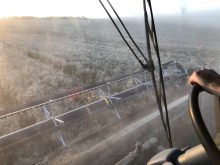A laboratory review of the end-use quality of sprouted wheat will lead to changes in how wheat is graded starting Aug. 1 this year.
The Canadian Grain Commission on Tuesday announced changes in store effective Aug. 1 for how Canadian wheat is graded, along with a list of clarifications and new housekeeping rules for the grading of other crops it regulates.
For one, the CGC will update its Official Grain Grading Guide’s definition of “severely sprouted” as a grading factor for western classes of wheat, following research on how far sprouting has to advance to affect end-use quality.
Read Also

Brazil to reap record soy crop in 2025/2026, increase exports
Brazil’s Conab said the country will reap a record soybean crop of 177.6 million tons in the 2025/2026 harvest year, according to data released on Thursday.
Under the current rule, a kernel of wheat is classified as “regular sprouted” if it has sprouts that are visible but still “within the contours of the germ.”
To be classified instead as “severely sprouted,” a kernel today must either be clearly “severely degenerated,” or clearly sprouted beyond the contour of the germ — or it must show signs of a sprout that’s broken or missing, whether with or without clear evidence of a sprout’s length or severity.
It’s been given that a kernel deemed “severely sprouted” contains a higher level of alpha-amylase than a “regular sprouted” kernel, which has negative impacts on the wheat’s falling number, which in turn is an indicator of the soundness of the grain.
But the research done last year and this year at the CGC’s Grain Research Laboratory found kernels of Canada Western Red Spring (CWRS) and durum wheats that show a sprout broken or missing, without clear evidence of a sprout’s length or severity, had alpha-amylase activity and impact on falling number in the same range as in “regular sprouted” wheat, rather than the other forms of “severely sprouted” wheat.
Thus, starting Aug. 1, kernels of sprouted western wheats with sprouts broken or missing, but without any clear evidence of a sprout’s length or severity, will be redefined as “regular sprouted” rather than “severely sprouted.” The impact on end-use functionality, the lab found, was “similar to that of regular sprouted kernels.”
Tolerances
Among other changes scheduled to take effect Aug. 1, tolerances for test weight and total foreign material are being matched up in most classes of western wheat that until now had different tolerances for “primary” or “export” use.
Under the new rule, test weight and total foreign material tolerances will be aligned to the “export” tolerances for all grades of:
- Canada Western Red Spring (CWRS);
- Canada Western Hard White Spring (CWHWS);
- Canada Western Extra Strong (CWES);
- Canada Western Soft White Spring (CWSWS); and
- Canada Northern Hard Red (CNHR) wheats.
On a related note, total foreign material “primary” and “export” tolerances for Canada Western Amber Durum (CWAD) wheat will also be lined up to the “export” tolerances for all grades.
An “export” tolerance is used when grain is destined for a market overseas and is shipped out of the country through a terminal grain elevator. Such a tolerance is set based on research and is used to ensure milling quality expectations are met for end-use customers, the CGC said Tuesday.
A “primary” tolerance, meanwhile, is set lower than an export tolerance; it’s used when grain is delivered directly to a primary grain elevator within Canada.
Sieves
Among other changes taking effect in the Grain Grading Guide starting Aug. 1, the process for determination of dockage, in the canola chapter, will clarify the process and the different-sized sieves that should be used.
That change, the CGC said, comes in the wake of concerns raised by producers about “inconsistencies in the process used at delivery.”
The guide’s definition of “processed sample” will also be updated in all chapters, in the wake of issues with samples submitted to the CGC for official grades from which dockage was already removed.
The guide will also see adjustment to the composition of dockage to include insect parts, and the definition for insect parts will be adjusted in the lentils, beans, chickpeas and fababeans chapters.
Also, in the canary seed chapter, the composition of dockage will be adjusted to include the percentage of hulled seeds in dockage, and the definition of foreign material and hulled seeds will be adjusted accordingly. — Glacier FarmMedia Network















